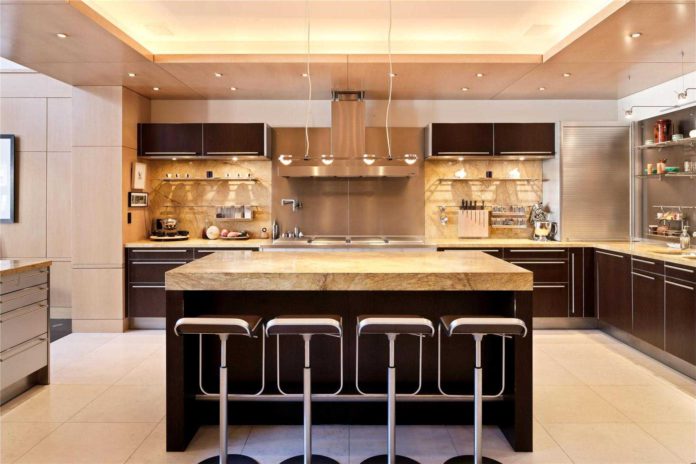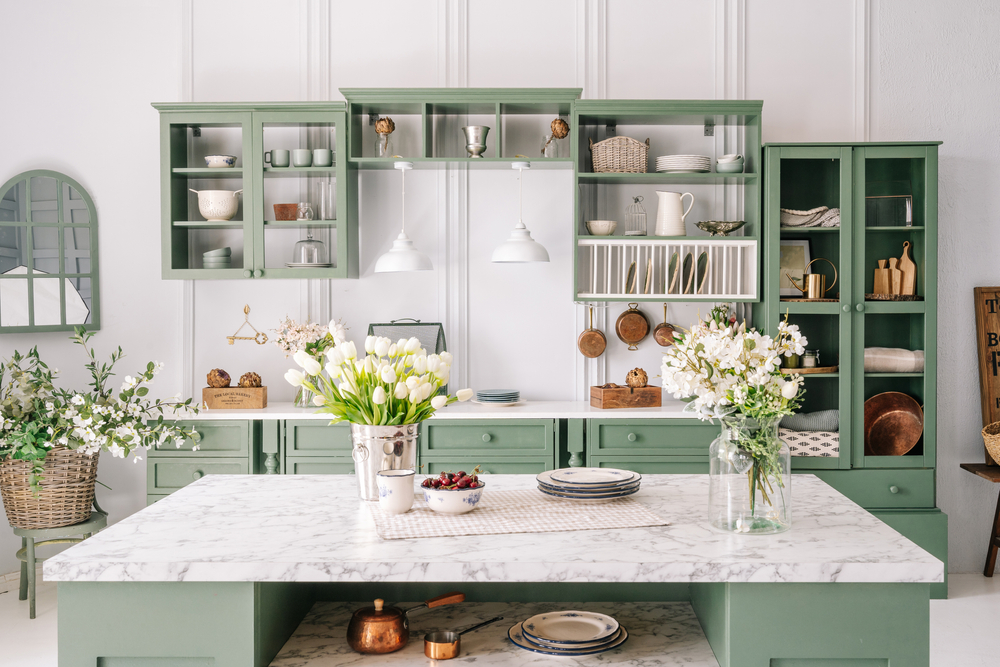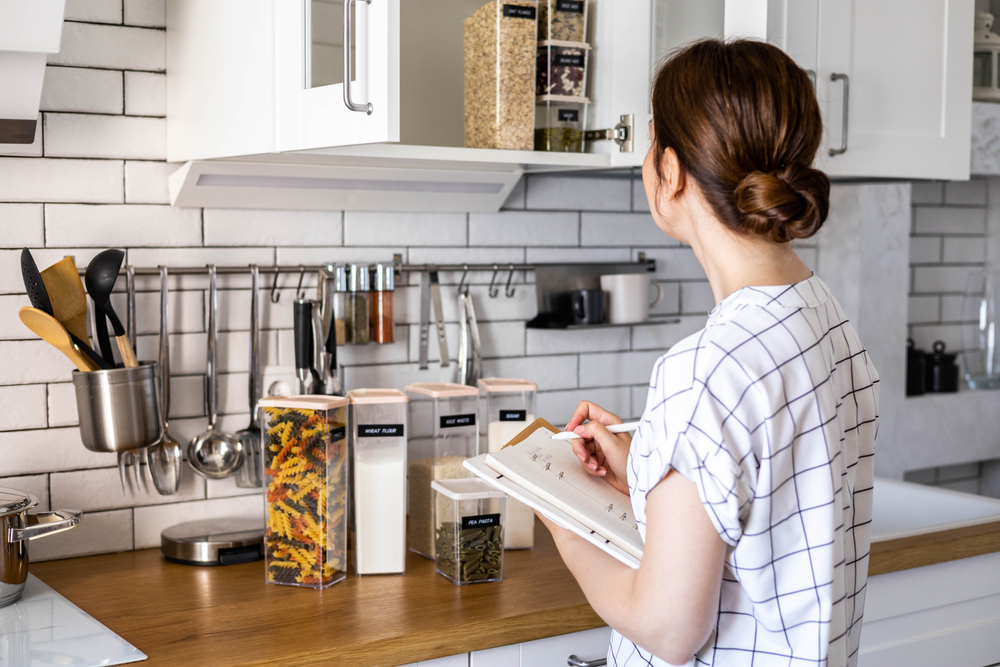As the hub of the household, even the coziest kitchen can become chaotic. Coordinating mealtimes becomes a real challenge when juggling each family member’s unique schedule, individual food preferences, and a fixed grocery budget. With a busy schedule, finding time for meal prep can be difficult.
Organizing your kitchen for maximum efficiency is a great way to avoid these and other challenges. For example, get your Shaker cabinets in shape by adding more storage features. By adopting some thoughtful strategies, you can create a kitchen that is the friendly and functional heart.
Source: brizmaker/Shutterstock.com
Step One: Create a Kitchen Organization Plan
Take a good look at your kitchen before you start writing your organization plan. Evaluate what works and what needs work. For example, if you have plenty of storage space, write a plan that makes the most of it. If your countertops are too cluttered, determine a solution to include in your plan.
Your kitchen should be set up to meet your family’s particular lifestyle, so plan accordingly. If everyone usually gathers in the kitchen for meals, dedicate space for a table and chairs. If adults share the cooking, organize the kitchen to make joint cooking easier. For instance, an island cooktop plus plenty of prep counter space is a recipe for success.
If you are lucky to have enough drawers and cabinets in your kitchen, simply determine which tableware, cookware, and bakeware go where. If not, consider adding some raised panel kitchen cabinets that coordinate well with your existing kitchen while adding a touch of timeless sophistication.
Your organization plan for the kitchen should include the following zones for maximum efficiency:
- Food storage
- Food preparation
- Dishes, glasses, cookware, and utensil storage
- Clean up
Step Two: Smarten Up Your Food Storage
According to the USDA, American families spent between 8% and 31% of their household budget on food in 2022, depending upon their income. Since this is a significant expense, make sure to optimize your food storage space with some budget-savvy strategies.
Source: Kostikova Natalia/Shutterstock.com
Clear, sealable containers are a great way to store your dry goods to keep them fresh and visible in the pantry. You can save space by transferring food like cereal from bulky cardboard packages to tall glass containers. You’ll be able to gauge your food supply at a glance when making your weekly grocery list.
In a well-organized kitchen, refrigerated foods require regular attention. One way to track the freshness of staples like milk and eggs is to keep them on a dedicated shelf. Check their “use by” dates often. Be sure to check the contents to verify if the food should go. Store your leftovers on another shelf, and go through them just before garbage day to discard the spoiled items. Don’t forget to sort through the produce drawers, too.
Step Three: Use These Helpful Hacks for Cabinet Organization
When it comes to organizing kitchen cabinets, the watchwords are convenience, efficiency, and sustainability. Convenience is key whenever you are cooking. You shouldn’t have to stop and hunt for the loaf pan when your bread is ready for the oven. Place all the cookware and utensils you use most often in one or two adjacent cupboards. Similarly, place that turkey roaster you use once a year on a high shelf.
While organizing, consider adding some cupboard storage units for added efficiency. They create more usable space and keep things tidier. For example, a two-tier cupboard rack adds twice the storage for shorter items. A lazy Susan keeps herbs and spice jars at your fingertips and helps eliminate duplicate purchases. A drawer spice rack is also a great way to organize these small but essential ingredients.
Another smart space-saver is to install shelves on the insides of your cupboard doors. They are ideal for keeping small items like birthday candles from getting lost at the back of the cabinet. You can also use these space-making shelves for your tea collection or sauce mixes.
Source: Archi_Viz/Shutterstock.com
Vertical racks minimize dish storage space in the cupboard. They even help protect your tableware from chips and cracks. Your cabinet provider can show you more great neatness hacks, such as pull-out drawers with vertical storage. These permanent elements help you sustain an organized kitchen.
Step Four: Keeping Your Kitchen Clutter-Free
Nothing says disorganization like a cluttered kitchen. Countertops are the place to start decluttering. First, assess the items on your counters. Are they essential to everyday food prep? For example, if you only use the espresso machine on special occasions, it doesn’t need to stay on the counter permanently. Put it away and reclaim that counter space.
If items seem to gravitate to your countertops and remain there for days, make it a policy to avoid this habit. Instead of stacking magazines on the counter, for instance, have a rack or basket to put them in, and rotate them frequently as new ones come in. Put your groceries away where they belong as soon as you bring them in, and place your reusable bags in a designated bin.
Remove any non-essential items taking up floor space that interfere with the flow of traffic in your kitchen. If that portable kitchen island doesn’t get much use, consider moving it to another room where it will. If the area rug in the breakfast nook has seen better days, remove it to uncover more of your attractive tile or Stonecreek SPC click flooring, or replace it with a new covering.
Ongoing Organization for an Efficient Kitchen
Make sure to keep your organized kitchen in top condition with ongoing maintenance. Set up a cleaning schedule for family members and make sure everyone sticks to it. Establish some simple rules to minimize clutter, like each person should load their dishes in the dishwasher instead of the sink. It isn’t difficult to create and maintain a well-organized kitchen; it just takes a bit of planning, creativity, and follow-through.




